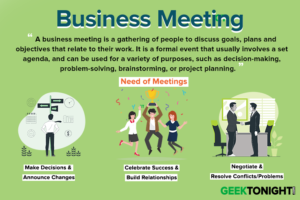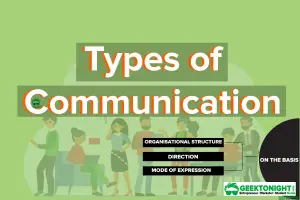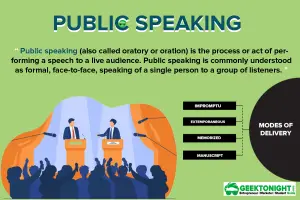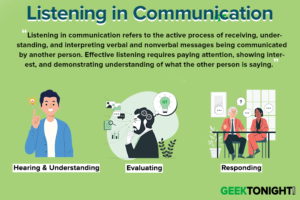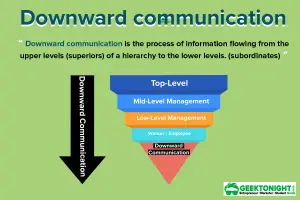What is Report Writing?
Report writing is a formal style of presenting objective facts and information. There can be various types of reports, such as academic reports, science reports, business reports, technical reports, and news reports. A report can be verbal or written. However, a written report is more formal than a verbal report.
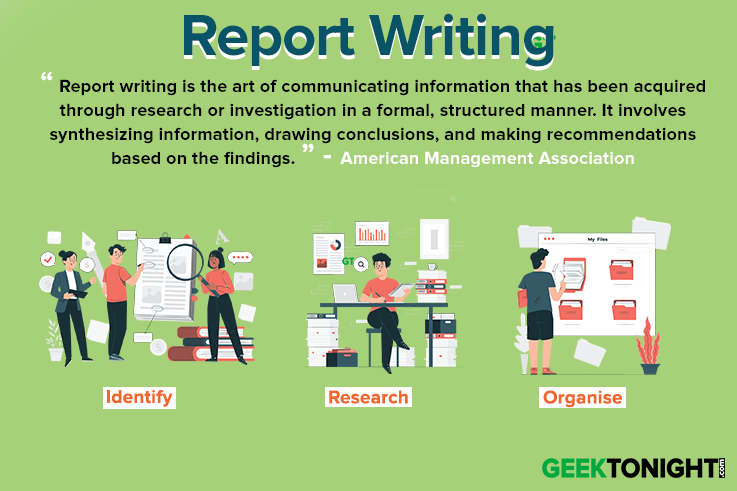
Table of Content
Report Writing Definition
Report writing is the process of organizing and presenting information in a clear, concise, and objective manner for a specific audience. It involves gathering data, analyzing it, and presenting it in a format that is easy to understand and relevant to the topic at hand. – The University of Wisconsin Writing Center
Report writing is the art of communicating information that has been acquired through research or investigation in a formal, structured manner. It involves synthesizing information, drawing conclusions, and making recommendations based on the findings. – The American Management Association
Report writing is the process of creating a document that provides information, analysis, and recommendations on a particular topic or issue. It requires the ability to organize and present data in a logical and meaningful way, as well as to convey complex ideas in a clear and concise manner. – The International Business Communication Standards (IBCS)
Report Writing Advantage
A written report also provides the following advantages:
- A written report presents a formal record of a transaction, which is not possible in a verbal report.
- A written report conveys a message without any distortion. On the other hand, a message can be easily misrepresented in a verbal report.
- A written report is more convenient for lengthy and distant communication.
- A written report requires a reader to think before responding to a message.
- Facts, figures and statistical data can be better represented graphically in a written report.
However, writing a report is not as easy as drafting a formal e-mail. A report is a brief, precise document. It is written for a specific audience with some specific objective. To write a report, you need to first thoroughly understand the purpose of report writing, then research information from various sources, verify the validity of information, analyse information, and then present findings or results. These findings must be reported objectively without personal biases.
A well-written report must have an effective objective analysis. Based on the analysis, you can recommend possible courses of action for the future. However, it is up to the report reader to accept the recommendations.
Therefore, while report writing, you must pay attention to why you are writing the report and who has asked you to write the report. This will help you investigate the information appropriately.
Parts of a Report
Following are the main sections of a formal report:
Introduction
This section indicates the purpose of the report, who has ordered the report, how the data is collected, and whether any recommendations are provided. In addition, the introduction section may also provide information on who has written the report and the date on which it is submitted.
Background
This section provides the background of a problem or a situation on which the report is written. In case the report is too lengthy, then instead of introduction, an executive summary should be written.
The purpose of an executive summary is to enable top executives and managers to get a quick snapshot of a long report without reading the entire report. Therefore, the executive summary comes before introduction. Of course, then there would be no background section.
Findings
This is the longest section of a report, which is written after the investigation is over. This section presents factual information without any interpretation or suggestions.
Conclusions
Each finding is summarised as a conclusion in this section. In the above sample report, there are four conclusions based on the summary of each paragraph in the findings section. These conclusions are listed numerically in the same order as the corresponding findings.
Recommendations
The final section provides a numbered list of recommendations, which are based on the list of the conclusion. Each recommendation uses the verb should. This is because the writer is simply giving suggestions and not making a decision. Therefore, the verb should is used instead of the verb will. However, there are exceptions:
- To give a strong recommendation: Use the verb must. For example, ‘The team managers must ensure that the break hours are not shortened.’
- To give a weak recommendation: Use the verb could. For example, ‘Having a coffee dispenser in the facility could boost the staff morale.’
Types of Reports
Reports exist in our academics and workplaces in so many forms that we may not even be aware of them. For example, a student submits a laboratory report to communicate the methods and results of scientific experiments conducted in a lab.
Academicians and business people use research reports to view scientific studies of an issue or a problem. Policy-makers read field study reports to read about the ground situation from branch offices and manufacturing plants. Similarly, there are progress reports, technical reports, functional reports, case studies, etc.
All these reports share the attributes, principles, and format of report writing, which are described above. These reports can be organised into three groups:
Informational reports
An informational report is used to objectively present information without any analysis. Examples of informational reports include the First Information Report (FIR), annual reports, monthly financial reports, or employee attrition reports. These reports only report the facts as they are.
For example, the police write an FIR to record details about a cognisable offence, such as personal details of the complainant/informant, place, date and time of occurrence, offence, description of the accused, witnesses, and complaint.
Similarly, a company presents an annual report to its shareholders to present details of its business activities and finances of the previous financial year. An informational report presents objective facts without analysing the reasons and conditions behind the reported situation.
For example, if someone wants to study information on a field trip, then he can ask for a site visit report. Similarly, if a manager wants to view the feedback of a training programme, then he can ask for the training feedback report from the trainer. If the head of a department wants to get an update on the different projects in his department, he can ask for progress reports from different project managers.
Analytical reports
An analytical report evaluates a problem or an issue and presents the outcomes of analysis to explain the causes of the problem, demonstrate relationships, or make recommendations.
For example, a scientific or market research report studies a problem scientifically by developing a hypothesis, gathering data, analysing data, and presenting findings and conclusions.
Similarly, a feasibility analysis report studies a problem and predicts whether the current solution or alternatives will be practical or will produce the desired outcome. Whenever you need to make a critical decision, then an analytical report is prepared. These reports help the decision-maker(s) analyse the prevailing situation.
For example, a company wants to decide where to open a branch office in a particular area. In this situation, an analytical report can evaluate the details of the property, such as infrastructure, land cost, competitive stores, etc., and then recommend the best site from the available options.
News reports
If you are working as or aspire to be a journalist, then you may need to write a press report. A press report is a newsworthy article in a newspaper, magazine or website. It is different from the press release by companies. A press release is an official statement of a company on an important subject or event. A press release generally focuses on one particular subject, such as a milestone, a launch, an anniversary, etc.
On the other hand, a press report discusses the subject in detail. A press release is a marketing tool used by companies to keep the general public and the media updated about its newsworthy occasions. It helps build a company’s visibility in the minds of its customers and community at large.
A press release is generally prepared by a company’s marketing or Public Relations (PR) team, whereas a press report is written by an independent journalist. Therefore, a press report presents more objective information than a press release, which is a company’s promotional mouthpiece. Just like informational and analytical reports, a press report requires considerable research on a subject before it is written credibly.
The author must ask the 5 Ws and 1 H – who, what, where, why, when, and how. Questions arise in the following manner:
- What happened?
- Where did it happen?
- When did it happen?
- Who was involved?
- Why did it happen?
- How did it happen?
After finding the answers, he must note down all the relevant facts that must be mentioned in the news report. These facts can be organised into the following three groups:
- Vital and interesting facts
- Not vital but interesting facts
- Not vital, not interesting, but related facts
By organising information into the above groups, the author will be able to include all the relevant facts into the news report. The facts must be specific. If there are gaps in the story and the related information is not available, then questions can be marked against them so that these can be researched further.
Next, the author must decide the type of news report he wants to write – informational or analytical. The former will provide objective and straightforward information, whereas the latter will also provide the author’s opinion on the subject.
After determining the type of news report to write, the author must create an outline or structure of the report. The most common structure is an inverted triangle, where the most important information is at the top.
A news report must provide the information that the readers want as soon as possible. If the news report is for a newspaper, then the most important news must be above the “fold”. The “fold” is the crease in the newspaper when it is folded in half. All the engaging stories are above the fold. Similarly, on a website, the most important information is at the top of the screen before one has to scroll down.
A news report must be written according to the audience. The author should ask the 5Ws with respect to the audience reaction, such as:
- Who is the audience?
- Where is the audience?
- What does the audience want to read?
- Why do they want to read it?
- When will they read it?
Structure of News Report
Finally, the structure of a news report is as follows:
- Lead
- Remaining details
- Informational news report
- Analytical news report
- Additional details
- Concluding sentence
Lead
The leading sentence of a news report is the most important section. It should tell what the news report is all about, why it is important, and what information the rest of the news report provides.
Remaining details
These provide the basic information of what happened, where it happened, when it happened, who was involved, and why it was remarkable.
Informational news report
In this report, the remaining details provide more information about the newsworthy item.
Analytical news report
In this report, the remaining details also provide the opinion of the author.
Additional details
These details help the reader learn more about the newsworthy item, such as additional facts about the subject, contact information, or interview quotes. These details comprise transitional elements that help build the flow of information. In an analytical report, these can also include counter-arguments and their authors.
Concluding sentence
The news report should end with a concluding sentence, which repeats the leading statement or a statement mentioning future developments.
Report Writing Process
This process will ensure that your report is accurate, clear, comprehensive and credible.
Identify
Before writing a report, identify the following parameters:
- Issue or problem: Identify the issue or problem to analyse.
- Audience: Identify who the audience is. Find out their background information. Determine why they would want to read the report.
- Purpose: Determine the purpose for which the report will be used.
- Scope and limitations: Identify the scope of the report. Determine the limitations of report writing.
- Expectations: Determine expectations regarding the format or structure of the report. Identify the models available for report writing. Determine whether there is a style guide and/or a marketing guide.
Research
To research the facts or information for report writing:
- Plan: Make a draft plan on how to analyse the problem and present the objective of the report.
- Collect data: Collect information based on the purpose of the report.
- Analyse: Finally, analyse and evaluate the collected information.
Organise
After gathering and analysing the required information, organise it as follows:
- Main points: Identify the main points of the report. These main points should be supported by adequate evidence.
- Additional information: Identify the supporting information that analyses and confirms the main points. This information should be placed in appendices.
- Logical structure: Organise the entire information into a logical structure to help the readers easily navigate to the desired part of the report.
- Write: After deciding the logical structure of the report, fill in the elements of the report, including executive summary, main body, introduction and conclusion.
- Revise: Finally, verify if it is appropriate for the problem, audience, and purpose.
Feasibility Reports
A feasibility report is a written document that analyses the proposed solution and examines whether it is feasible considering various types of constraints such as financial, social, environmental, social, technical, and legal that can make it impossible for a solution to be opted.
Feasibility reports assess the practicality of following a particular course of action for a project. It advises whether it will be feasible to opt for a particular course of action or will this proposal or plan work? These are written internal reports that advise on consolidating departments or to organise a wellness programme for employees or to outsource company’s accounting or social media or to move the manufacturing unit to a new location.
Some companies hire a professional consultant to write feasibility reports in order to investigate a problem. These reports help in deciding whether to proceed or reject the proposed option.
- Introduction
- Overview of the Project
- Objectives of the Project
- The Need for the Project
- Overview of Existing Systems and Technologies
- Scope of the Project
- Deliverables
- Feasibility Study
- Financial Feasibility
- Technical Feasibility
- Resource and Time Feasibility
- Risk Feasibility
- Social/Legal Feasibility
- Considerations
- References
Proposal Writing
A business proposal is defined as a written document from a seller that offers a particular service or product to a prospective buyer. Business proposals are important in scenarios where a buyer might consider multiple prices in a transaction.
A good business proposal considers the buyer’s requirements and puts forth the seller’s proposal in a way that favours the seller’s products and services, and persuades the buyer about the offer. A business proposal is a critical document as it determines the difference between success and failure in a venture. Business proposals can be:
- Solicited: These are requested by clients themselves or submitted in response to an advertisement published by the client. Solicited business proposals generally have a better chance of success since they are tailored to the requirements of the person receiving the proposal.
- Unsolicited: These are submitted to potential clients even though they did not request for one. These are non-specific proposals and have no direct connection to the client’s requirements. Sellers use them to market a product or service to a prospective customer.
Because proposals are time-consuming, it is the best to start with available templates if possible. You will save a lot of time if you start with a proposal template that matches what you need and then customise it according to your requirements.
A business proposal includes various sections which are defined as follows:
Cover letter
In the other article, you studied writing cover letters for a job application. A business proposal also needs a cover letter because a good cover letter will stimulate interest in the proposal. Make sure to highlight your positives and personalise them to the client to whom you are sending the business proposal.
Executive summary
This is where you give the client a ‘problem statement’ to help him identify the challenges and requirements in his business. This is because in order to persuade the client to do business with you, you first need to make sure that the client realises they have those needs. Then you briefly state how you will be able to help them meet those requirements.
Proposal
The proposal is the part where you offer a detailed solution to the challenges and needs of the prospective client. This is the main reason for submitting a business proposal so it should be as detailed as possible, addressing all the needs of the client.
You should explain to the client all services that you can provide. You should tailor your list of services to suit the particular client’s needs but include other services that you may provide. Also include an estimated project schedule and time frame.
Pricing information
Most buyers consider the price of services before offering a contract. Thus, getting accurate pricing information is crucial. However, two points must be kept in mind. One it is important to be exact with the pricing and the second is to never negotiate below what you think the project is worth.
For smaller projects, a ‘fee summary’ will do the job. But a ‘fee schedule’ is needed for bigger projects, where payments need to be broken down to specific milestones.
Terms and conditions
It is in your interest to get legal counsel to review the proposal as this will cover your business against claims.
Business Communication Notes
(Click on Topic to Read)
- What is Business Communication?
- What is Communication?
- Types of Communication
- 7 C of Communication
- Barriers To Business Communication
- Oral Communication
- Types Of Non Verbal Communication
- What is Written Communication?
- What are Soft Skills?
- Interpersonal vs Intrapersonal communication
- Barriers to Communication
- Importance of Communication Skills
- Listening in Communication
- Causes of Miscommunication
- What is Johari Window?
- What is Presentation?
- Communication Styles
- Channels of Communication
- Hofstede’s Dimensions of Cultural Differences and Benett’s Stages of Intercultural Sensitivity
- Organisational Communication
- Horizontal Communication
- Grapevine Communication
- Downward Communication
- Verbal Communication Skills
- Upward Communication
- Flow of Communication
- What is Emotional Intelligence?
- What is Public Speaking?
- Upward vs Downward Communication
- Internal vs External Communication
- What is Group Discussion?
- What is Interview?
- What is Negotiation?
- What is Digital Communication?
- What is Letter Writing?
- Resume and Covering Letter
- What is Report Writing?
- What is Business Meeting?
- What is Public Relations?
Business Communication Notes
(Click on Topic to Read)
- What is Business Communication?
- What is Communication?
- Types of Communication
- 7 C of Communication
- Barriers To Business Communication
- Oral Communication
- Types Of Non Verbal Communication
- What is Written Communication?
- What are Soft Skills?
- Interpersonal vs Intrapersonal communication
- Barriers to Communication
- Importance of Communication Skills
- Listening in Communication
- Causes of Miscommunication
- What is Johari Window?
- What is Presentation?
- Communication Styles
- Channels of Communication
- Hofstede’s Dimensions of Cultural Differences and Benett’s Stages of Intercultural Sensitivity
- Organisational Communication
- Horizontal Communication
- Grapevine Communication
- Downward Communication
- Verbal Communication Skills
- Upward Communication
- Flow of Communication
- What is Emotional Intelligence?
- What is Public Speaking?
- Upward vs Downward Communication
- Internal vs External Communication
- What is Group Discussion?
- What is Interview?
- What is Negotiation?
- What is Digital Communication?
- What is Letter Writing?
- Resume and Covering Letter
- What is Report Writing?
- What is Business Meeting?
- What is Public Relations?




